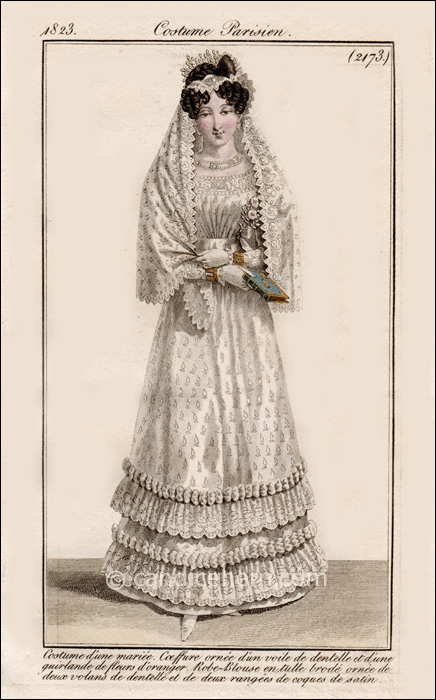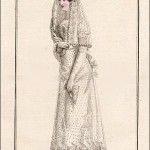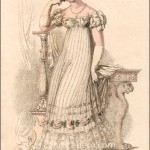Journal des Dames et des Modes, Paris, August 15, 1823
 “Costume d’une mariée. Coeffure ornée d’un voile de dentelle et d’une guirlande de fleurs d’oranger. Robe-Blouse e tulle brodé ornée de deux Volans de dentelle et de deux rangées de coques de satin.”
“Costume d’une mariée. Coeffure ornée d’un voile de dentelle et d’une guirlande de fleurs d’oranger. Robe-Blouse e tulle brodé ornée de deux Volans de dentelle et de deux rangées de coques de satin.”
This print is later than what I typically collect, but because it is shows a rare bridal dress, I thought it appropriate to add to my collection.
As usual with this publication, the only description of the dress is provided in the print’s caption. The magazine text discusses the latest fashion trends, but does not mention this print at all. Fortunately, this caption is more specific than is typical, providing more detail on the dress.
So, we know that she wears a lace veil, trimmed in what the British would call vandyking, and that she wears a garland of orange blossoms in her hair. Though we have long associated orange blossoms with brides, the earliest reference I have seen in fashion prints is in this 1819 print. The tradition of brides wearing orange blossoms is said to have come from ancient China, where the orange blossom represented purity and innocence. The idea spread to Europe in the late Middle Ages, but not to England until the early 19th century.
The dress is made of embroidered tulle, with two flounces of lace, each surmounted with with satin trimming. Note that by this date, the waistline has returned almost to its natural state. The sleeves appear to be long, worn with short gloves. Notice the gold bracelets worn over the sleeves at the wrist. The necklace looks to be of pearl.







